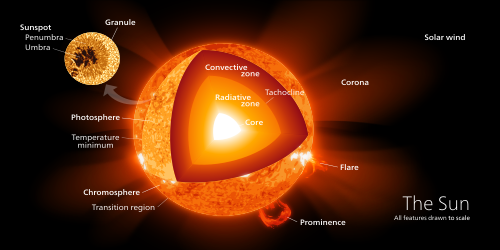Featured
- Get link
- X
- Other Apps
The classification of the Sun
The classification of the Sun, like other stars, is based on its spectral characteristics, luminosity, and evolutionary stage. In this article, we will explore the classification of the Sun, delving into its spectral type, luminosity class, and its place in the Hertzsprung-Russell (H-R) diagram.
1. Spectral Type:
The spectral type of a star is determined by analyzing its spectrum, which reveals the wavelengths of light that are absorbed or emitted by the star's atmosphere. The spectral type is represented by a letter and a Roman numeral.
1.1. G-Type Main Sequence Star:
The Sun is classified as a G-type main sequence star, specifically a G2V star. The letter "G" indicates its spectral type, which corresponds to its surface temperature. G-type stars have temperatures ranging from around 5,000 to 6,000 Kelvin. The Sun, with its effective temperature of approximately 5,500 degrees Celsius, falls within this range.
1.2. Main Sequence Stars:
The "V" in the spectral classification of the Sun represents its luminosity class, which indicates its evolutionary stage. The "V" stands for "main sequence," indicating that the Sun is currently in the main phase of its stellar evolution. Main sequence stars, including the Sun, are in a stable phase where they are fusing hydrogen into helium in their cores.
2. Luminosity Class:
Luminosity class categorizes stars based on their luminosity or brightness relative to other stars of similar spectral type. It provides insights into the size, mass, and evolutionary stage of a star.
2.1. Main Sequence (V) Stars:
As mentioned earlier, the Sun belongs to the main sequence, or V, luminosity class. Main sequence stars are in a stable phase of hydrogen fusion in their cores and form a diagonal band on the Hertzsprung-Russell diagram, which plots stellar luminosity against surface temperature.
3. Hertzsprung-Russell (H-R) Diagram:
The Hertzsprung-Russell diagram is a fundamental tool in stellar astronomy that relates the luminosity and temperature of stars. It helps astronomers understand the different stages of stellar evolution and the relationships between various types of stars.
3.1. Location of the Sun:
On the H-R diagram, the Sun falls in the middle of the main sequence, known as the "Main Sequence Turn." This region represents stars that are in a stable phase, fusing hydrogen into helium, like the Sun. The Sun's position in the middle of the main sequence indicates that it is a relatively average-sized and average-brightness star.
4. Other Characteristics:
In addition to its spectral type and luminosity class, the Sun possesses other notable characteristics that contribute to its classification and understanding:
4.1. Mass and Radius:
The Sun has a mass of approximately 333,000 times that of the Earth and a radius of about 1.4 million kilometers, making it significantly larger and more massive than most other stars in the universe.
4.2. Lifetime and Evolution:
Based on its mass, the Sun is estimated to have a total lifetime of about 10 billion years. It is currently about 4.6 billion years old, suggesting that it is middle-aged. As the Sun continues to burn hydrogen in its core, it will eventually exhaust its nuclear fuel and evolve into a different phase, swelling into a red giant.
4.3. Magnetic Activity:
The Sun exhibits magnetic activity, including the presence of sunspots, solar flares, and coronal mass ejections. These phenomena are associated with the Sun's strong magnetic field, which plays a crucial role in space weather and influences the behavior of the Sun's outer layers.
In conclusion, the Sun is classified as a G2V star, belonging to the G-type main sequence and exhibiting characteristics typical of main sequence stars. Its position on the Hertzsprung-Russell diagram places it in the middle of the main sequence, indicating its stability and ongoing hydrogen fusion. Understanding the classification of the Sun provides valuable insights into its properties, evolutionary stage, and its place among the vast array of stars in the universe.
- Get link
- X
- Other Apps

Comments
Post a Comment